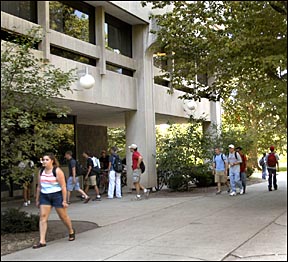|
|
|
|
|
September 12, 2003Answers to some common questions about the two calendars
What academic calendar proposals are under consideration? The academic calendar task force initially developed four academic calendar proposals. After receiving extensive campus input on the proposals last spring, President Gregory Geoffroy narrowed the options to the two calendars that received the most support -- Calendar B (which adds a week to winter break, includes a 10-day January term, shortens the academic semester by one week, and increases the length of individual class periods) and Calendar A (the current academic calendar). What are some of the key transition costs associated with changing calendars? Most transition costs that would be associated with a move from the current calendar to Calendar B involve computer software, electronic databases and distribution of information to students and faculty. For example, class and room scheduling software and databases would need to be modified to account for different starting dates for the semesters, different break periods and different class lengths. Similarly, information displayed on the Web and in printed matter may need to be modified in format as well as content. The addition of a January term would require changes in scheduling software for classes, rooms, payroll and, possibly, the residence halls. Changes may be required in advising, financial aid, individual calendar software (Outlook, Lotus Organizer, PALM OS) and databases. Another transition cost is that the campus community would have to adjust to different class periods, starting times, semester start periods and breaks. What is a January term (J-term)? The January term proposed in Calendar B is a 10-day session, held in early January between fall and spring semesters. Such sessions are held at many other universities, particularly private ones. Students would be able to complete one-, two- or possibly three-credit courses during this session. Class periods would be longer during the J-term than a regular semester. For example, a student taking a one-credit course would put in 75 minutes of class time per day. A student taking a three-credit course would put in 3 hours and 45 minutes per day, achieving a semester's worth of classroom instruction in the term. Would students be required to attend a January-term under Calendar B? J-term would be optional. It would provide an opportunity for students to fit another class between semesters. Students who might take advantage of J-term include those who need another class or two for graduation, those who are in Ames over the break, or those who do not have good work opportunities between semesters. Would departments or faculty receive compensation for teaching during a January term? A significant portion of J-term tuition, as much as 80 percent, will be allocated to the departments. Individual departments and faculty will determine whether a given faculty member will teach during J-term and whether J-term courses will be taught as part of a faculty member's annual teaching load, as unpaid overload, or with extra compensation for an increased teaching load. Will Calendar B, with later starting dates and the addition of a J-term, affect energy costs over summer and winter break? Calendar B's later start in August would reduce air conditioning costs significantly. Estimated savings are approximately $100,000 per year. A later start for spring semester also would reduce heating costs. Many students have opposed a longer winter break in the past (although a strong majority of students did prefer Calendar B to Calendar A). What aspects of Calendar B might compensate for the longer winter break? Summer break is one week longer under Calendar B than under Calendar A. Full-time summer jobs typically pay significantly more per hour than part-time, in-semester jobs. The longer winter break does mean more down time for students without jobs, but provides more earning time for students who find employment. Will the addition of a two-day fall break under Calendar B affect Thanksgiving break? Calendar B proposes a full week for Thanksgiving break, as does Calendar A. How does the shorter semester in Calendar B affect lab classes? Departments with laboratory sessions would lose at least one week of labs, and there's a possibility that two weeks of labs could be lost during the fall semester. This is a real concern, and the task force is considering some changes to Calendar B to come up with a better solution. The most likely is the elimination of the two-day, mid-fall class break and starting spring semester the day after the Martin Luther King Holiday instead of the Thursday following it. Will student-athletes be able to become athletically eligible for spring semester during January term? No. J-term will be considered part of the spring semester. Courses taken during J-term will not appear on a student's transcript until after the end of spring semester and so will not affect spring term eligibility. When is the most likely starting term for a new academic calendar if adopted? Given all the adjustments that would have to be made, the most probable date for starting a new academic calendar would be fall 2005 or fall 2006. It is unlikely that the calendar would change in 2004. A number of individuals have suggested that a reading/study period before finals each semester be incorporated into a new calendar. Why is this option not on the table? A reading/study period is one or more days set aside for study; classes aren't held during the period. The option of a reading/study period was seriously discussed by the Academic Calendar Task Force. Input from various groups on campus showed some support for this idea, but it was not strong and the idea was discarded. The complete FAQ is online at: http://www.iastate.edu/news/cal/faq/. |
|
Ames, Iowa 50011, (515) 294-4111 Published by: University Relations, online@iastate.edu Copyright © 1995-2003, Iowa State University. All rights reserved. |
